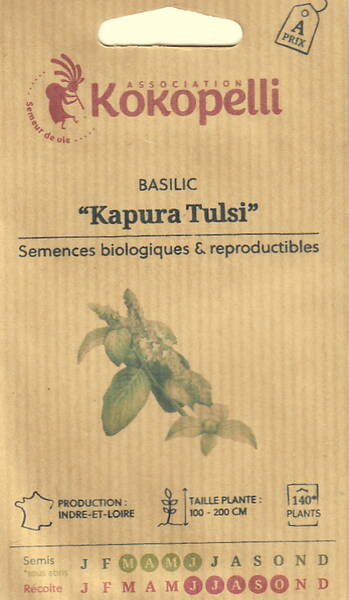A perennial subshrub of the Lamiaceae family.
A rare and useful plant grown as an annual in the cool climate of Estonia.
Forms green, fluffy leaves with a very strong camphor smell. Flowers are white with reddish-orange pollen.
The stems are green-violet, hairy, with sessile glands. The leaves are oblong-elliptical, 25-40 mm long and 10-20 mm wide, the edges are serrated, covered with white hairs on both sides.
The inflorescence is dense. The calyx is 2-3.5 mm long at the peduncle, 3-4.5 mm long at the fruit. The corolla is white, with a purple tint, 3-4 mm long, the lobes are pubescent on the back. The nut is black, ovoid, smooth or finely tuberculate, secretes mucus when wet.
Reaches 60 cm in height (sometimes almost 2 meters under very good growing conditions).
Ocimum kilimandsharicum is resistant to the fungus Fusarium oxysporum ssp . basilicii , as well as to the basil downy mildew Peronospora belbahrii .
The leaves are used as a flavoring in food products, the plant also has medicinal properties, produces essential oil and is used as an insect repellent.
The main component of essential oil is camphor. It is used as a raw material for obtaining camphor oil, as a honey plant, for flavoring tea.
Ocimum kilimandscharicum is a unique plant that combines ornamental, medicinal and culinary value. It is suitable for growing in gardens, greenhouses and even in pots. If you are looking for an aromatic and useful herb with exotic origins, Kilimandscharicum basil is a great choice.
For successful cultivation, it is important to provide it with enough light, moderate watering and protection from severe frosts. With proper care, the plant will delight you with abundant greenery and useful properties throughout the season.
* The homeland of Kilimanjaro basil is the mountainous regions of East Africa.
This type of basil is distinguished by its high content of essential oils (camphor, eugenol, linalool), resistance to cold and a pronounced camphor-mint aroma. Unlike common basil (Ocimum basilicum), it has stronger medicinal properties and is used in medicine, cooking and aromatherapy.
Botanical features:
-
Height: from 60 to 120 cm (in tropical conditions it can reach 2 m).
-
Stem: straight, branched, with a purple tint.
-
Leaves: green with purple veins, slightly pubescent, pointed, up to 10 cm long.
-
Flowers: small, white-pink or lilac, collected in spike-shaped inflorescences.
-
Aroma: Intense, with camphor, woody and minty notes.
Useful properties and application:
1. Medicinal properties:
-
Anti-inflammatory and antibacterial action – used for colds, coughs and infections.
-
Pain-relieving effect – helps with headaches and muscle pain.
-
Natural repellent - repels mosquitoes and other insects.
-
Antioxidant activity – helps slow down cell aging.
2. Culinary uses:
-
The leaves are added to teas, marinades and meat dishes (due to the strong aroma, they are used in small quantities).
-
Essential oil is used in aromatherapy to relieve stress and improve breathing.
3. Benefits for the garden:
-
Attracts bees and other pollinators, improving the yield of neighboring crops.
-
Can be used in mixed plantings as a natural insecticide.
Growing and care.
Climate conditions:
-
It loves heat, but can withstand short-term frosts down to -5°C.
-
In regions with cold winters, it is grown as an annual or moved indoors.
Landing:
-
By seeds: sow in March-April for seedlings or in open ground after the soil has warmed up to +15°C.
-
Cuttings: easily rooted in water or moist substrate.
Location and soil:
-
Prefers sunny areas or light partial shade.
-
The soil should be light, drained , with neutral acidity.
Watering:
-
Moderate, without overwatering. Drought-resistant, but with a lack of moisture the leaves become smaller.
Pruning and shaping:
-
Pinching the top stimulates bushiness.
-
Regular pruning extends the growing season.
Precautions:
-
Due to the high camphor content, it is not recommended for pregnant women and people with epilepsy.
-
In large doses it can cause dizziness and nausea.
Traditionally, this type of basil is used in East Africa for its medicinal properties for colds, coughs, bronchitis, abdominal pain, diarrhea, measles, nervous system disorders, tumors, microbial and fungal infections, etc., as well as for protection against mosquitoes.












